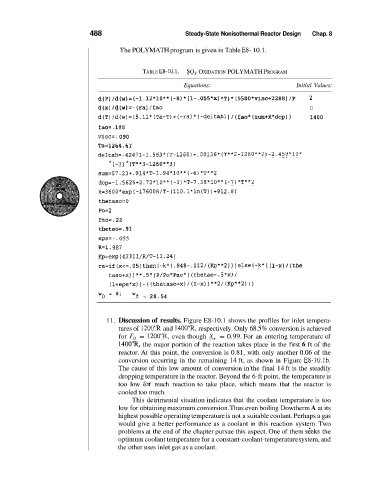Page 518 - Elements of Chemical Reaction Engineering Ebook
P. 518
488 Steady-State Nonisothermal Reactor Design Chap. 8
The POLYMATH program is given in Table E8- 10.1.
TABLE E8-10.1. SO3 OXIDATION POLYMATH PROGRAM
Equations: Initial Values:
d(P) /d(w)=(-1.12*10**(-8) *(1-.055*x) *T)* (55OO*visc+2288) /P 2
d(x) /d(w)=-(ra) /fa0 0
d(T)/d(w)=(5.11*(Ta-T)+(-ra)*(-deltdh) !/(fao*(sum+x*dcp)) 1400
fao= .E38
visc=. 090
Ta=1264.67
de1tah=-42471-i.563*(T-1~60}+.00136*(T**2-1260**2)-2.459*1~*
*
* (-7) (T**3-1260**3)
sum=57.23+.014*T-1.94*10**(-6)*TR+2
dcp=-l.5625+2.72*10**(-3)*T-7.38*10**(-7)*T**2
k=3600*exp(-176008/T-(110.l*ln(T) )+912.8)
thetaso=O
€0=2
Pao=. 22
thetao=.91
eps=-. 055
R=l. 987
Kp=exp(42311/R/T-11.241
ra=if(x<=.05)then(-k*(.848-.012/(Kp**2)))else(-k*( (1-x) /(the
taso+x))**.5*(P/Po*Pao*((thetao-.5*~)/
1)
(lteps*x))-( (thetaso+x)/(l-x))**2/(Kp**2)
wO = "' = 28.54
11. Discussion of results. Figure E8-10.1 shows the profiles for inlet tempera-
tures of 1200"R and 1400"R, respectively. Only 68.5% conversion is achieved
for To = 1200"R, even though X, = 0.99. For an entering temperature of
1400"R, the major portion of the reaction takes place in the first 6 ft of the
reactor. At this point, the conversion is 0.81, with only another 0.06 of the
conversion occurring in the remaining 14 ft, as shown in Figure E8-10.Ib.
The cause of this low amount of conversion in'the final 14 ft is the steadily
dropping temperature in the reactor. Beyond the 6-ft point, the temperature is
too low Lor much reaction to take place, which means that the reactor is
cooled too much.
This detrimental situation indicates that the coolant temperature is too
low for obtaining maximum conversion. Thus even boiling Dowtherm A at its
highest possible operating temperature is not a suitable coolant. Perhaps a gas
would give a better performance as a coolant in this reaction system. Two
problems at the end of the chapter pursue this aspect. One of them s;eks the
optimum coolant temperature for a constant-coolant-temperature system, and
the other uses inlet gas as a coolant.

